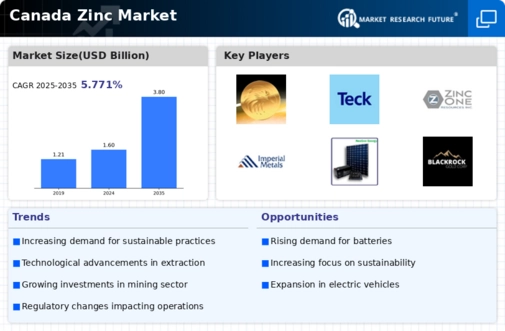The Canada Zinc Market has experienced significant developments over recent years, driven by the increasing demand for zinc in various industrial applications, including construction, automotive, and electronics. As one of the leading producers of zinc globally, Canada benefits from rich mineral reserves and a regulatory framework that supports mining activities. The competitive landscape is characterized by a mix of established mining companies and emerging enterprises, each striving to enhance their operational efficiencies and expand their production capacities. Factors such as technological advancements, strategic partnerships, and environmental sustainability measures are pivotal in shaping the competitive dynamics of the market.
Players in this sector are continuously innovating to optimize resource extraction methods while maintaining compliance with environmental regulations, thus mitigating challenges and bolstering their market positions. Glen Eagle Resources has established a notable presence in the Canada Zinc Market through its strategic focus on the exploration and development of zinc-rich projects. The company leverages its geological expertise to identify promising mineral deposits and implement cost-effective extraction methods. With a commitment to sustainability and community engagement, Glen Eagle Resources has built a positive reputation in the industry, enhancing its attractiveness to investors and stakeholders.
The company’s operational efficiency, coupled with its strategic partnerships, strengthens its competitive edge within the Canadian market. The emphasis on developing innovative technologies and continuous improvement in operational processes positions Glen Eagle as a significant player in meeting the growing demand for zinc in Canada. Teck Resources has solidified its reputation as a powerhouse in the Canada Zinc Market, primarily recognized for its extensive portfolio of key products and services that include zinc, copper, and metallurgical coal. The company is noted for its significant mining operations, which focus on sustainable and responsible resource development.
Teck Resources places a strong emphasis on employing advanced mining techniques and integrating innovative technologies to maximize efficiency and reduce environmental impacts. Mergers and acquisitions have further expanded Teck's market presence, allowing it to strengthen its asset base and enhance productivity. The company's commitment to long-term value creation, reflected in its investment in infrastructure and community development, positions it as a leader in the Canadian zinc sector. With a robust pipeline of projects and a proactive approach toward addressing industry challenges, Teck is well-positioned to capitalize on the evolving dynamics in the zinc market.






















